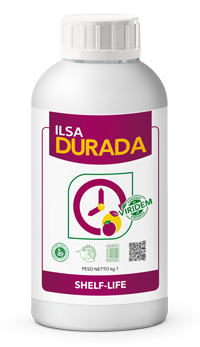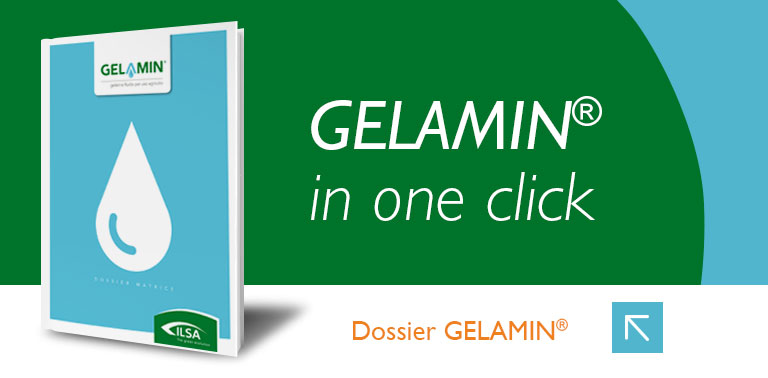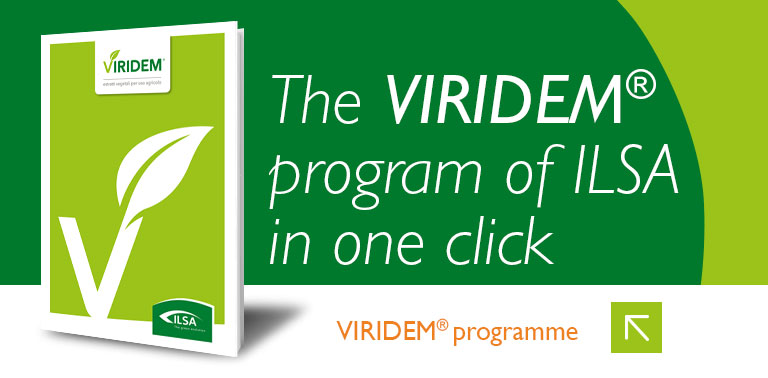PROMOTES SHELF-LIFE
The shelf-life of fruits and vegetables after harvest is a decisive factor for the value of final production. By delayingthe occurrence of rot and loss of consistency and savour, in fact, one can ensure the product final quality, even ifthe product is destined for the most distant markets or large retailers’ shelves. This phenomenon is ruled by both processes at the cell level (loss of cell turgor and, therefore, of tissue turgor) andbiotic factors, due to the attack of pathogenic agents causing rot and rancidity.
ILSADURADA, based on an enzymatic hydrolysate of Fabaceae, allows increasing the shelf-life of fruits andvegetables, which, despite being easily perishable products, stay good for a longer time.
The very high quantity of natural triacontanol, vitamins (B6 in particular) and specific compounds with anintense antioxidising activity -such as aromatic poliketides andnaringin derivatives-,polyphenolic acids and phenylpropanoids (galic acid, chlorogenic acid, caffeic acid, etc.) allows ILSADURADA to extend the post-harvestlife of tomatoes, peppers, melons and also leaf vegetable crops, especially those meant to be sold as fresh cut.
ILSADURADA affects secondary metabolism, thanks to the accumulation of anti-oxidants and the activity of theenzymes (peroxidase and catalase) that protect from oxidative stress, caused by the presence of free radicals.
ILSADURADA is suited for fruit and leaf vegetable crops, whose market destination implies a longer post-harvestlife.
Chemical and physical features
- LIQUID BROWN COLOUR
- pH 5,5 ± 0,5
- DENSITY 1,15 ± 0,02 kg/dm3
- CONDUCTIVITY E.C. 1,75 ± 0,20 dS/m
COMPOSITION
- Total Aminoacids 5 %
- Free Aminoacids 1,5 %
- Vegetal Triacontanol (mg/kg) 12
Contains in particular
- ENZYMATIC HYDROLYSATE OF FABACEAE
Characterising substances
- PLANT-DERIVED TRIACONTANOL, AROMATIC POLYKETIDES, NARINGIN DERIVATIVES, GALLIC ACID, CAFFEIC ACID, CHLOROGENIC ACID, VITAMIN B6
ACTIONS OF THE CHARACTERISING SUBSTANCES
| PRESERVATION OF CONSISTENCY AND SAVOUR | OXIDATION REDUCTION | |
|---|---|---|
| PLANT-DERIVED TRIACONTANOL |

|

|
| AROMATIC POLYKETIDES |

|

|
| POLYPHENOLIC ACIDS AND PHENYLPROPANOIDS |

|

|
| VITAMIN B6 |

|
Doses and methods of use of the fertilizer
-
Fruit
-
Blackberry1,5 - 2 kg/ha2-3 applications, every 10-12 days, from the veraison stage
-
Blackcurrant1,5 - 2 kg/ha2-3 applications, every 10-12 days, from the veraison stage
-
Blueberry1,5 - 2 kg/ha2-3 applications, every 10-12 days, from the veraison stage
-
Kiwi2-2,5 kg/ha2-3 applications, every 10-12 days, from pre-veraison
-
Raspberry1,5 - 2 kg/ha2-3 applications, every 10-12 days, from the veraison stage
-
Redcurrant1,5 - 2 kg/ha2-3 applications, every 10-12 days, from the veraison stage
-
-
GrapeVine
-
All2-2,5 kg/ha2-3 applications, every 10-12 days, from pre-veraison
-
-
Leafy vegetables
-
Arugula1,5-2 kg/ha2-3 applications, every 7 days, from 3 weeks before cutting
-
Chicory1,5-2 kg/ha2-3 applications, every 7 days, from 3 weeks before cutting
-
Endive1,5-2 kg/ha2-3 applications, every 7 days, from 3 weeks before cutting
-
Lettuce1,5-2 kg/ha2-3 applications, every 7 days, from 3 weeks before cutting
-
Spinach1,5-2 kg/ha2-3 applications, every 7 days, from 3 weeks before cutting
-
-
Legumes and potatoes
-
Potato1,5-2 kg/ha2-3 applications, every 10-12 days, from pre-veraison
-
-
Pome fruits
-
Apple2-2,5 kg/ha2-3 applications, every 10-12 days, from pre-veraison
-
Pear2-2,5 kg/ha2-3 applications, every 10-12 days, from pre-veraison
-
-
Stone fruits
-
Apricot2-2,5 kg/ha2-3 applications, every 10-12 days, from pre-veraison
-
Cherry2-2,5 kg/ha2-3 applications, every 10-12 days, from pre-veraison
-
Nectarine2-2,5 kg/ha2-3 applications, every 10-12 days, from pre-veraison
-
Peach2-2,5 kg/ha2-3 applications, every 10-12 days, from pre-veraison
-
Plum2-2,5 kg/ha2-3 applications, every 10-12 days, from pre-veraison
-
-
Vegetables
-
Courgette1,5-2 kg/ha2-3 applications, every 10-12 days, from pre-veraison
-
Cucumber / Gherkin1,5 - 2 kg/ha2-3 applications, every 10-12 days, from pre-veraison
-
Melon1,5-2 kg/ha2-3 applications, every 10-12 days, from pre-veraison
-
Pepper1,5-2 kg/ha2-3 applications, every 10-12 days, from the veraison stage
-
Ready-prepared vegetables1,5 - 2 kg/ha2-3 applications, every 7 days, from 3 weeks before cutting
-
Strawberry1,5 - 2 kg/ha2-3 applications, every 10-12 days, from the veraison stage
-
Tomato1,5-2 kg/ha2-3 applications, every 10-12 days, from the veraison stage
-
The dose indicated in the table has been calculated by taking into account an irrigation volume of about 500-600 litres of water per application. The doses shown should be considered as merely indicative and may vary according to pedoclimatic conditions and average yields expected.












.png)
















